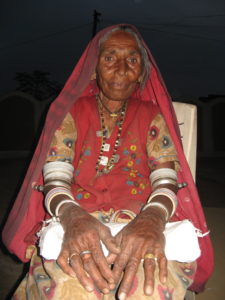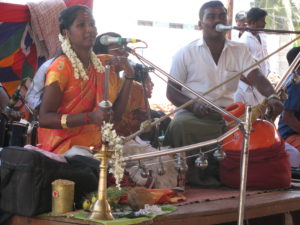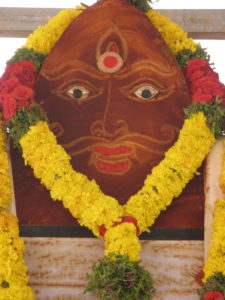I was fortunate to be awarded Professional Development funding from Creative Scotland to attend the Chennai Storytelling Festival as principal artist and to undertake research in traditional forms of storytelling and music in India.
I began my journey in the remote westernmost corner of Rajasthan. The golden forted city of Jaisalmer rises like a giant sand castle out of the arid Thar Desert close to the Pakistan border like a scene from Arabian nights.
Jaisalmer holds many stories of the countless merchants passing through as they transported fine materials, cotton, silks, spices, camels and opium amongst other goods. Its position on the overland route between Delhi and Central Asia – which ultimately led to the vast markets of the Middle East, North Africa and Europe – meant the city grew rich on the proceeds, as the magnificent palaces and havelis of merchants bear witness.
The city is also hugely important to Hindus, as it is closely associated with Lord Krishna. Lord Krishna has always been one of my favourite Indian Gods as he of plays the flute as do I, although I’m sure he would naturally have been a far finer player with his Godly skills.
According to ancient mythology, Krishna and Bhima had come to Jaisalmer for a ceremony, where Krishna prophesised that a descendent of his Yaduranshi clan would one day establish a kingdom there. Lord Krishna created a spring by casting a spear, which is still in existence and his prophecy carved in rock. This tale was told to Rawal Jaisel, a descendant of the Yaduranshi clan by a sage called Eesul in the 12th century. Encouraged by the meeting, he moved his capital to the location on the rock where the present city stands and named it after himself.
 The people of the city took me to their hearts when they heard me practicing flute and I was invited to the palace to give a performance to Rani [Queen] Meghna Kumari Singh alongside her husband Maharaj [King] Vikram Singh Ji Bhati and their special guest, the Crowned Prince of Uidapur, amongst other invited guests.
The people of the city took me to their hearts when they heard me practicing flute and I was invited to the palace to give a performance to Rani [Queen] Meghna Kumari Singh alongside her husband Maharaj [King] Vikram Singh Ji Bhati and their special guest, the Crowned Prince of Uidapur, amongst other invited guests.
The House of Nachana in Jaisalmer is a 300-year-old sandstone haveli, which belongs to the descendants of the erstwhile ruling dynasty of Jaisalmer. The Nachana family are Bhatis and they belong to the Lunar clan. The family traces their birth line lineage to Lord Krishna and way back before him to Rishi Attri from where the Lunar clan is known to have begun.
Sure enough, being part of Lord Krishna’s family music and dance plays a very integral part of their lifestyle, traditions, rituals, customs and festivities. The family has given patronage and full support to its artists and musicians and always entwined relationships between the two, which continue to this day. The Nachana family is very involved in promoting the Jaisalmer singers, musicians, storytellers and all kinds of local artists to reach their full potential.
Meghna Kumari Singh – with her non-profit organisation Uttistna Foundation [which means Arise, Awaken and perform conscious action] – is working with these artist communities to promote them and to involve the women and girls of these families so they too can carry their family traditions forward and be on a world stage.
In the days that followed, I visited many times while they shared tales of the regions and fed me lots of food, and I in turn shared stories and tunes from Scotland and Ireland. The family had on a previous visit to the region introduced me to a flute player I had been searching for but who had been proving elusive.
 Hailing from the Bheel community in Rajasthan, Taga Ram Bheel is one of the most famous Algoza players in the region. Coming from a family of labourers and shepherds, Taga Ram self-taught himself the Algoza. As a child he would watch his father playing and was so intrigued by the magical instrument that he would steal his father’s well-hidden flute and run away to play with it while his sheep and goats grazed around him. He would start to play along with any song he would hear on the radio or in the Temples around. He now performs worldwide and is President of the Algoza Society, recipient of many prestigious awards and a skilled instrument maker.
Hailing from the Bheel community in Rajasthan, Taga Ram Bheel is one of the most famous Algoza players in the region. Coming from a family of labourers and shepherds, Taga Ram self-taught himself the Algoza. As a child he would watch his father playing and was so intrigued by the magical instrument that he would steal his father’s well-hidden flute and run away to play with it while his sheep and goats grazed around him. He would start to play along with any song he would hear on the radio or in the Temples around. He now performs worldwide and is President of the Algoza Society, recipient of many prestigious awards and a skilled instrument maker.
The moment I met Taga Ram Bheel and began playing together, we clicked. We effortlessly improvised and couldn’t stop laughing in between tunes. Celtic music and the music of this region of Rajasthan have huge similarities.
He invited me to his village, Moolsager, where a group of musicians where waiting to greet me with welcoming songs. His mother and father, in their 80’s, along with his wife, many children and grandchildren all treated me like a family member. I was invited to stay with Taga Ram and his family in their village. They live in conical shaped houses, which have thatched roofs and are painted with traditional artwork of the region. We spent our days playing flutes together. At night we would sit around a flickering campfire beneath the twinkling stars sharing tales and tunes.


 After my time in Rajasthan I travelled to Tamil Nadu in the South of India. My first port of call was the ancient city of Mamallapuram. Famed for its exquisite and extensive stone carvings and sea temple, I was able to see scenes and characters from the great Indian epic tales depicted in artwork. Most of them were carved from rock during the 7th century reign of Pallava King Narasimhavarman 1, whose nickname Mamalla [Great Wrestler] gave the town its name.
After my time in Rajasthan I travelled to Tamil Nadu in the South of India. My first port of call was the ancient city of Mamallapuram. Famed for its exquisite and extensive stone carvings and sea temple, I was able to see scenes and characters from the great Indian epic tales depicted in artwork. Most of them were carved from rock during the 7th century reign of Pallava King Narasimhavarman 1, whose nickname Mamalla [Great Wrestler] gave the town its name.
 I was attending the annual Mamallapuram dance festival, which lasts for an entire month. Exponents of Eight Indian classical dance forms, hundreds of folk and tribal dances complete with storytelling, clowning and circus skills take to the stage each evening accompanied by live musicians. Every evening for a week I sat spellbound for several hours taking in the extraordinary dances from Tamil Nadu and all regions of India. Here I was able to witness the great epic tales of India the Ramayana and Mahabharata along with folk tales being danced out before me.
I was attending the annual Mamallapuram dance festival, which lasts for an entire month. Exponents of Eight Indian classical dance forms, hundreds of folk and tribal dances complete with storytelling, clowning and circus skills take to the stage each evening accompanied by live musicians. Every evening for a week I sat spellbound for several hours taking in the extraordinary dances from Tamil Nadu and all regions of India. Here I was able to witness the great epic tales of India the Ramayana and Mahabharata along with folk tales being danced out before me.
So, by day I experienced stories captured within ancient stone carving, and by night I relished stories performed with dance and music against the magnificent backdrop of Pavalla rock sculptures as the moon shone overhead.
 From Mamallapuram I travelled to Chennai, which is the bustling capital of Tamil Nadu, previously known as Madras. Upon arrival I met with Chennai Storytelling Festival Director Eric Miller, who had agreed to accompany me on a week-long field trip. An hour after meeting we both leapt on a train for an epic journey, which took 14 hours and included an overnight sleeper, travelling to the most Southern region of Tamil Nadu.
From Mamallapuram I travelled to Chennai, which is the bustling capital of Tamil Nadu, previously known as Madras. Upon arrival I met with Chennai Storytelling Festival Director Eric Miller, who had agreed to accompany me on a week-long field trip. An hour after meeting we both leapt on a train for an epic journey, which took 14 hours and included an overnight sleeper, travelling to the most Southern region of Tamil Nadu.
Nagercoil is situated close to the tip of the Indian Peninsula and lies in undulating terrain between the Western Ghats and Arabian Sea. The evergreen forests of the hill regions are inhabited by as many as 36 tribes, who live in small hamlets of 20 families dispersed in and around the forest areas. The Kani traditional occupations include the production of handicrafts such as baskets, mats, cane work and seasonal collection of minor forest products like honey and bees wax, and cultivating edible plants such as tapioca, banana, millets, and cash crops such as pepper, coconut, rubber, areca and cashew nut.
 The region with its near equatorial position and distinct geographical zonation’s into hill, plain and coastal regions is found to be an area rich in medicinal plants, as Eric discovered when he was studying for his PHD. The Kani Tribes also have a wealth of ancient traditions in the arts of storytelling, singing, lullabies, and musical games involving actions and rhymes, which they use for learning language. The friendship and trust built by Eric over the time he lived in the forests with the Kani meant I was able to gain a unique invitation to spend time with the tribe.
The region with its near equatorial position and distinct geographical zonation’s into hill, plain and coastal regions is found to be an area rich in medicinal plants, as Eric discovered when he was studying for his PHD. The Kani Tribes also have a wealth of ancient traditions in the arts of storytelling, singing, lullabies, and musical games involving actions and rhymes, which they use for learning language. The friendship and trust built by Eric over the time he lived in the forests with the Kani meant I was able to gain a unique invitation to spend time with the tribe.
We were met by a member of the Kani Tribe called Ven Murrigen who guided us on a walk through the forests for many hours, sharing knowledge of the plants and trees medicinal uses and the many stories and songs connected to nature.
We finally reached a tiny hamlet which reminded me of my family’s home in Donegal with its thatched houses and wells. Men were stamping on what I discovered to be pepper and gathering tamarind into huge piles. A member of the tribe quickly climbed a coconut tree and brought down a coconut, lopping off the lid with an axe and offering me a drink of the fresh sweet coconut milk.
I was taken to a long house, which was filled with women, girls and young babies. When I held a baby in my arms the women all spoke to me, and I found out from Ven Murrigen, who was translating, that they wanted me to sing a lullaby. I sang the first which came to mind, which was ‘Rock-a-bye Baby’, much to the delight of the crowd which had gathered and who cheered and clapped. Then women took it in turns to hold a baby and sing a song.
 One of these women was Rajamaal, which means Kings Mother. She is the tribes much adored and respected chief storyteller and singer. At 80 years of age she is still sharp as a knife and could tell stories and sing songs from the Kani traditions for hours without drawing breath.
One of these women was Rajamaal, which means Kings Mother. She is the tribes much adored and respected chief storyteller and singer. At 80 years of age she is still sharp as a knife and could tell stories and sing songs from the Kani traditions for hours without drawing breath.
We returned to the main meeting house where people gathered round and paused in their work. I shared some tunes on the flute and then Rajamaal regaled us all with stories. Like all great storytellers from oral tradition, she lived and saw every moment of the tales she shared, complete with actions and songs. She was supported by another storyteller and singer who at points in the stories would join in with actions and song. On other visits I would meet with a storyteller and singer from the younger generation called Banu, who is one of the few people continuing the Kani traditions.
I was able to document my time with the Kani tribe with film footage, photography and recordings. I was initially sheepish about being invasive, until I started playing my flute and they all began to film me with their mobile phones.
Whilst in Nagercoil I was also researching an ancient form of storytelling and music which has intrigued me for many years. Villupattu – also called the Bow Song – is known as the mother of all Indian storytelling. This form of narration interspersed with music is popular in the Southern Indian regions of Kerala and Tamil Nadu. The stories are mythological, folktales and social tales dealing with topics such as domestic violence or aids. The main storyteller plays on a giant bow which is covered in tiny bells and sits within a gourd. There is a secondary storyteller/singer and several musicians.
 I went to meet the region’s most famous villupattu artist – a woman called Shuba Manni. She had been studying and performing villupattu her entire life and has received many awards for her work. I was thrilled to have my first up close glimpse of the famous bow used during performances. Initially, I was disappointed as it was made from metal rather than the traditional wood I had seen in pictures. Shuba explained that many years earlier an artist had made one from metal as it could be assembled and transported on buses easily, unlike the old wooden bows. This of course made complete sense.
I went to meet the region’s most famous villupattu artist – a woman called Shuba Manni. She had been studying and performing villupattu her entire life and has received many awards for her work. I was thrilled to have my first up close glimpse of the famous bow used during performances. Initially, I was disappointed as it was made from metal rather than the traditional wood I had seen in pictures. Shuba explained that many years earlier an artist had made one from metal as it could be assembled and transported on buses easily, unlike the old wooden bows. This of course made complete sense.
She showed me a hefty book, which was handwritten and filled with all the stories used in her repertoire. Myths, legends, folktales, and new material, which Subha writes for specific requests. Very often the Indian government employs Shuba and her troupe to set up in bus stops and deliver stories with a social message.
She told me that the following day they would be doing a performance at a temple celebration and invited me along. Her sons told me the story of Ezeke that they would be performing so I would understand it.
The temple was on the outskirts of Nagercoil and was the place of the dead and cremations. People were busy bedecking the temple and effigies of its Gods with flowers.
There were loud speakers and tannoys erected up and down the roads of the village so the music and stories could be broadcast. Gradually people began to arrive dressed in their colourful saris and hair tied with fresh jasmine which scented the air.
 Subha would tell her story, and then they would leap into musical accompaniment and singing. As she spoke the secondary storyteller would join in, having a direct conversation with the audience. Whilst speaking and singing she would make rhythms on the huge bow like instrument as the tiny bells jangled. At one point a procession of people entered the temple banging drums and walking in a circular motion around a statue of the temple God. Sudha and the musicians became more frenetic in their playing and suddenly a man went into a trance state and became possessed by the temple God. He ran around the temple shouting and screaming before being held down and doused with water to bring him back into present consciousness.
Subha would tell her story, and then they would leap into musical accompaniment and singing. As she spoke the secondary storyteller would join in, having a direct conversation with the audience. Whilst speaking and singing she would make rhythms on the huge bow like instrument as the tiny bells jangled. At one point a procession of people entered the temple banging drums and walking in a circular motion around a statue of the temple God. Sudha and the musicians became more frenetic in their playing and suddenly a man went into a trance state and became possessed by the temple God. He ran around the temple shouting and screaming before being held down and doused with water to bring him back into present consciousness.
I was informed that later that evening a pig would have its throat cut and hung upside down so the temple God could drink its blood. The following day the pig would be cooked, and the entire village would join in the feast and celebration.
From the Southernmost tip of India, I returned alongside Eric Miller to Chennai to attend the storytelling festival, which is now in its seventh year and hosted 22 events across ten days. Themes for the 2019 edition were ‘Storytelling for Creativity, Teaching, Training & Healing’ and ‘Tales about Strong & Clever Girls & Women’.
For the duration of the festival I stayed with storyteller and journalist Sudha Umashanker and her husband. Sudha leads historical storytelling tours of Chennai and has created an extensive library for children in her home where she’s been running weekly storytelling sessions for several years. I was shown great kindness and hospitality and learnt so much about Indian culture and traditions from my stay with the Umashankers. Sudha also shared many tales about the Scottish inhabitants of Madras who had lived there during the East India times.
 As part of the festival I had been invited by the British Council to give two performances in their theatre in Chennai. The first was alongside my friend Deepa Kiran, who many will remember from her visit to the Scottish International Storytelling Festival.
As part of the festival I had been invited by the British Council to give two performances in their theatre in Chennai. The first was alongside my friend Deepa Kiran, who many will remember from her visit to the Scottish International Storytelling Festival.
I met Deepa initially when performing at the International Storytelling Festival in Iran. When I discovered we had a shared love of weaving tales I mentioned Deepa to SISF Festival Director Donald, who bought her to Scotland. As part of her visit, we created several programmes together including weaving tales and tunes from Scotland, Ireland and India.
When Eric Miller invited me to perform at the Chennai Storytelling Festival, I suggested that Deepa and myself repeat and grow the same programme in India, and it was a joy to share the stage with her again.
My second performance at the British Council was a solo one, based on the theme of strong women from Scottish and Irish folktales and epic sagas. The British Council in Chennai was the perfect venue and both performances had large and responsive audiences.
For the duration of the festival there was an evening programme featuring storytellers from India, Canada, America and Scotland, each taking to the stage to share stories and songs. It was inspiring to see so many talented performers and witness how strong the storytelling scene is in India. I also had the opportunity to speak to artists about their work.
As part of the festival outreach, I was invited to give a solo performance of Macbeth, told in oral tradition, to MA English students from Loyola College. This was followed by a lively discussion about the role of Lady Macbeth and Diana Tso, a Canadian storyteller, commented:
‘Such a wonderful excitement and joy to witness Marion Kenny’s story of Macbeth! She captivates us from her mesmerising flute playing to her dynamic energy and draws listeners up close to the characters in her story with a touch or a whisper.’
I was also delighted to give a performance on the theme of Eco Stories to MA and PHD students studying ecology and the environment at Loyola College. The course director P. Mary Vidya Porselvi has had a book published by Routledge India entitled ‘Nature, Culture and Gender: Re-reading the Folktale’. It is heartening to learn of the many ways storytelling is being incorporated into Indian education.

At NKT teacher training college, I was invited to lead a workshop for two hundred teachers in storytelling as a teaching tool in education. I was supported by a fine team of storytellers from Chennai who translated my stories and instructions into Tamil as well as the lively discussions, which took place with participants. I repeated the same workshop to professional storytellers at the World Storytelling Institute, which was one of the festival venues.
From the ancient to the modern, from stories told in ancient carvings, dance and music, from the deserts of the North to the mountains, forests and sea of South- India is a living, breathing land of tales and tunes. My hope is that this wonderful cultural exchange will strengthen ties between the storytelling communities of India and Scotland.
‘Marion’s rhythmic, musical and physical interactions with the workshop participants were stunning, and she absolutely overcame the language barrier, skilfully working alongside various Chennai storytellers as translators throughout. She is a real professional both as a performer and conductor of storytelling workshops. Her emotions as she told stories and enacted the characters were strong and clear, taking us along with her on the journey. I think numerous members of Chennai’s professional storytelling community learned a lot from Marion’s direct, warm, personal and often conversational style.’
(Dr Eric Miller, Artistic Director of Chennai Storytelling Festival)
All photographs © Marion Kenny
More on Marion Kenny





